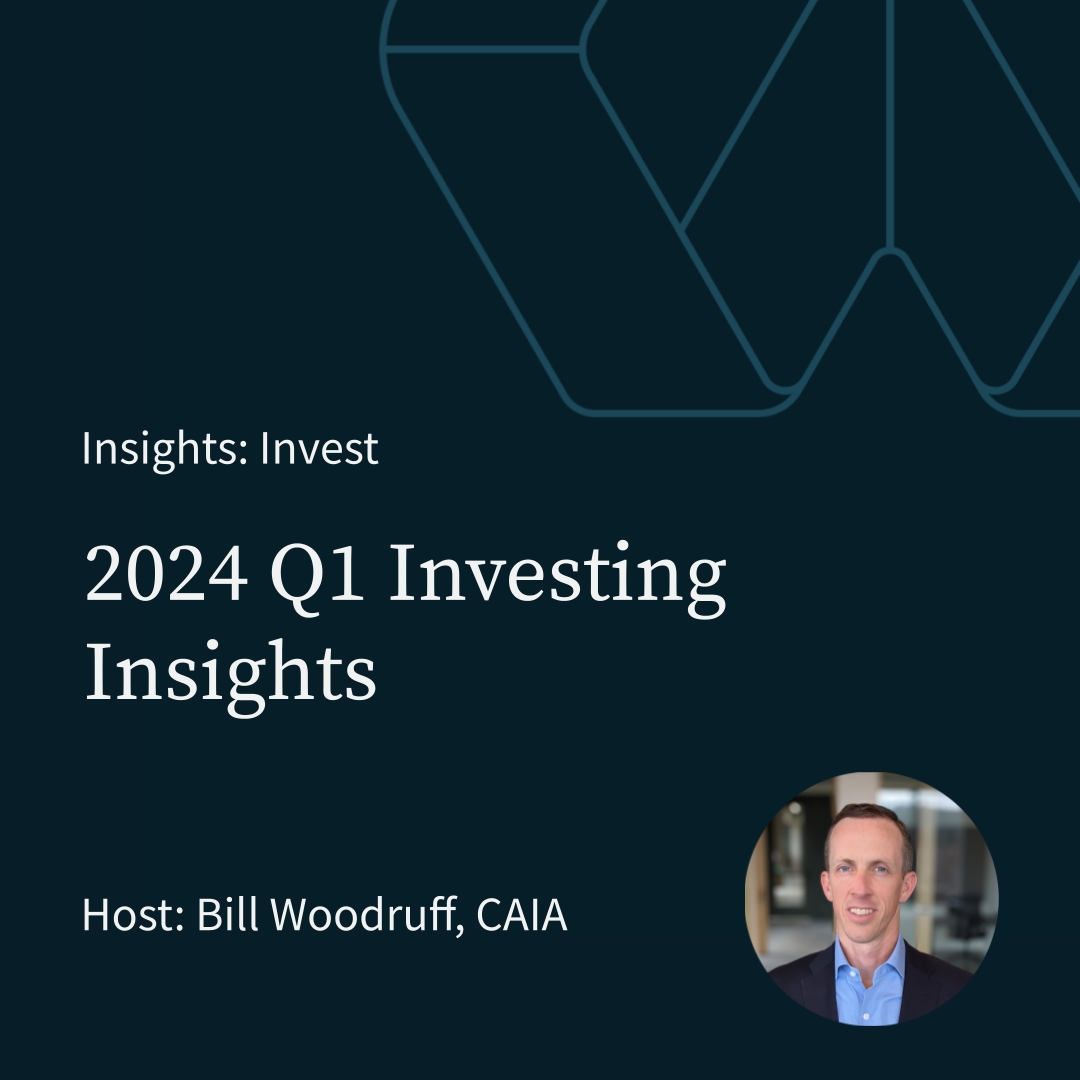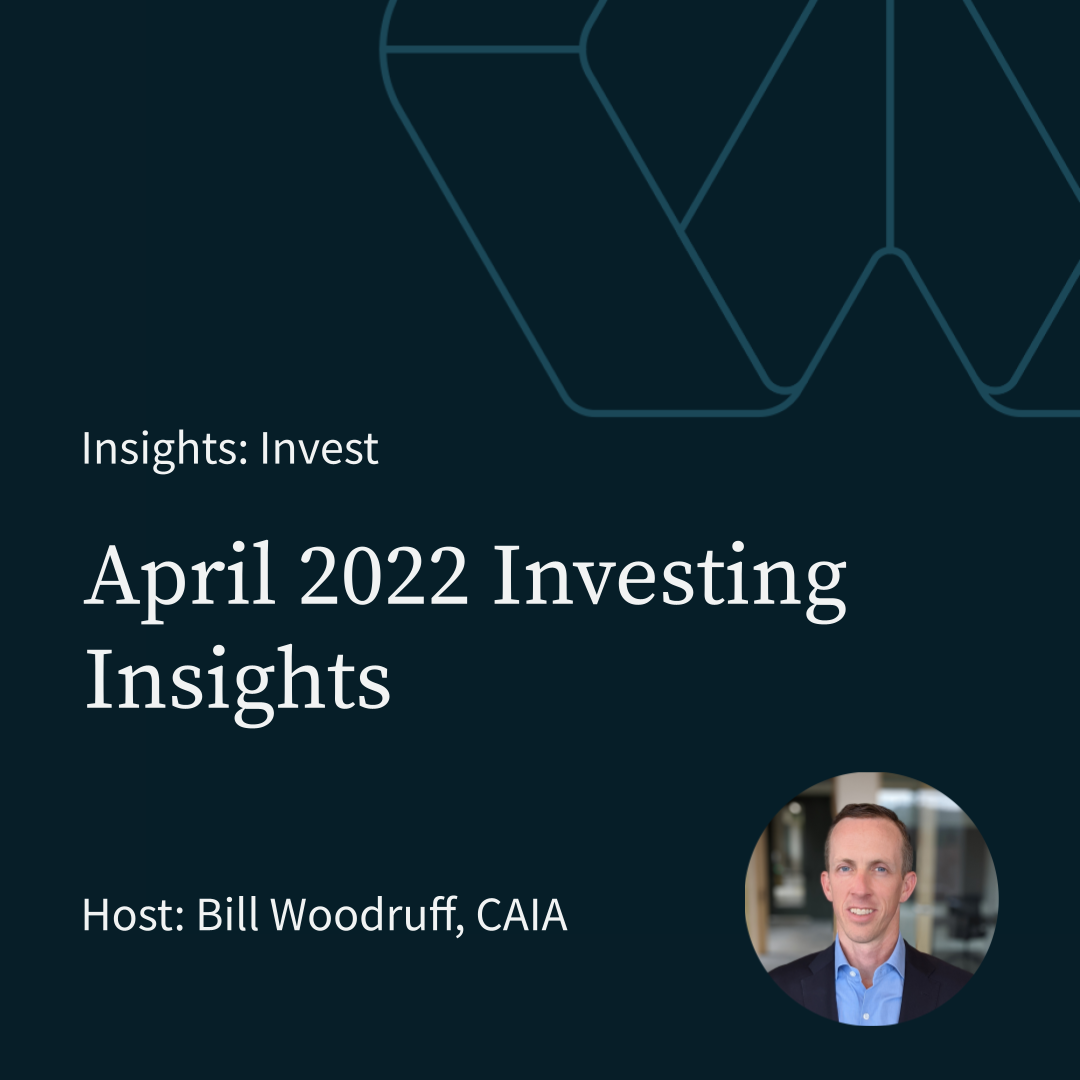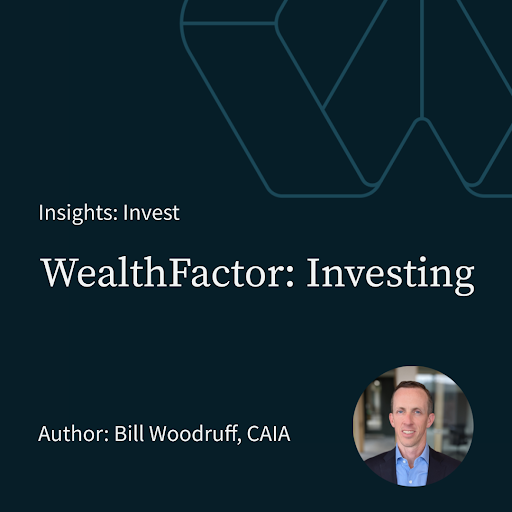04 2022 Investing Insights
Slides:
Replay:
Transcript:
My name is Bill Woodruff. I'm the founder and responsible for the investment activity at WealthFactor. Well factor we provide our insights through a recorded presentation on a quarterly basis. And it's generally my belief that it's likely to do more harm than good most of the time in evaluating and thinking about global financial markets invest and investing frequently. However, we've end with mixed feelings. So we are making an exception to that. And we'll be sharing some thoughts as of the end of April 2022. Given the increased amount of volatility and some of the uncertainty, it's my belief that the biggest driver to long term investing success is having a plan. And sticking to that plan. I think that's far more important than the composition of the portfolio. In many cases, there's certainly some exceptions to that, when the portfolio is comprised of things like concentration, illiquidity, or leverage, willing to endure. So, before I get too far, and let me say a few things for compliance purposes. This call is for informational purposes only and may be recorded statements made during this call or the opinions of the speaker and are subject to risk and uncertainty, some of which are significant in scope. And by their very nature beyond the control of wealth factor, there can be no assurance that such statements will prove to be accurate. And actual results and future events could differ in a material way from said statements. Historical results are not necessarily indicative of future performance.
So kicking things off, this is something I've used in the past. But the question that is the natural one to ask whenever there's increased levels of volatility, and declines in asset prices, and this is a unique period, where we're seeing declines in both stocks, global stocks, as well as us high quality fixed income, or we're seeing interest rates rise, and fixed income fall.
History historically, and over long periods of time, high quality fixed income tends to move in the opposite direction of stocks, helping to reduce an overall portfolios declines. So in asking the question, is this time different? I think it's worth highlighting. And what we've tried to do here and sharing this piece of information is kind of looking back over. And there's some randomness, as there almost always is when you look at data and try to look at facts. And I always guard against the idea that we're trying to draw conclusions from this, that might help us for predictive purposes. The purpose for most of what I share is really for perspective, and in support of maintaining, positioning, and staying disciplined with an investment plan. So in this analysis, it's
looking at the beginning of each decade, although from 1980, all the way to 2020. And then we're accelerating that a little bit and looking as at things as of right now, or as of the end of April of 2022, which most of the content in this, and that we've organized today is as of the end of April 2022. And so if we look at each deck at the beginning of each decade, and if we were to get really granular and look within each decade, there are persistently reasons to be I suppose fearful, and many of them repeat and are overlapping. So today, it's the concern of high inflation and rising interest rates, Russia's invasion of Ukraine has been COVID. And the disruptions of
4:03
the supply chain, which is perhaps was driving increases in inflation. And now most recently, there's concerns of recession driven by all of those things, plus a high probability that the Fed will tighten and remove its easy money policies.
4:23
And so what we've done here, what you can see here, in addition to kind of getting some perspective in terms of what the returns were in some of those first years of each decade, is also see the growth of a portfolio over the long run, or even you know, as the as you go from top to bottom, shorter periods of time. It's my belief. So the conclusion here is there are persistently reasons not to invest. And it's my belief that investors that are adept at generally ignoring those and understanding that they are
5:00
relative to a properly diverse portfolio, and a proper time horizon, and a portfolio that matches that time horizon. Most, if well, historic if history is any guide, which perhaps this time is different, I don't have a crystal ball, it's generally not then productive to look in at current environments, current concerns, and use that as a reason or basis to deviate from a plan. This next piece of data and shared information is looking back at historic declines and then rallies. And so you know, there's a lot of data in here. And rather than dig into the data and the points, I'm just going to leave this and if it's of interest to you, feel free to pause it on this page and dig into some of the information or, or reach out to me and, you know, we're happy to discuss and dig in more, more in more detail. But the thing that would highlight in regards to the current period of of uncertainty and increased volatility and declines, is that declines are inherent, and inherent part of publicly traded financial markets. And it takes and so investors, investors should be guarded against taking lots of risk, if they're prone to want to reevaluate their investment portfolio plan, after declines, declines will always happen, I believe, and and but at a minimum, investors should be understand that that that investors will happen will likely happen, and it will happen at unexpected times. And most likely, the worst possible thing that one could do is deviate from the direction or plan that was put into place. Probably during a period where there's less volatility and not in a decline this page, we have s&p valuations. And so as we see some declines in equity markets, this increase in volatility, we're seeing valuations come back in they were they were perhaps extended, which isn't uncommon, as a driver to declines. But we're seeing an s&p valuations approach 25 year averages. And so I think this is a reason to stay invested lower if something is valued relative to what you pay for it, I think there's a greater reason to own an asset. And so we're looking at the s&p 500. Here, which, with this page, we're showing the this is kind of a continuation of the concept that they're consistently declined. So this is from 1980, to two all the way into two this year. And what the red dot shows is the worst decline in each one of those calendar years. And the bar shows what the end of that year look like. And so this, if we look at this year, we've got a 14% decline going right now. And that's also the year to date performance. But if we look back historically, at the number of declines in the eight to 20% range, they're pretty regular. And in many of the years, perhaps not all, equity markets finished positive, or at least better than that maximum or a period of decline. And so,
8:41
again, declines are something that that are a natural part of publicly traded financial markets, and investors should expect them and be prepared to largely avoid trying to deviate from their investment plan when they do occur. Or, you know, to the extent they have a part of an investment plan, that is my belief that if anything, those investment plans should be built around adding to exposure after declines based on the idea that one should be preferring, you know, to the extent that there's a basis for activity to be buying after declines or buying low, and generally avoiding selling however, selling has to happen in retirement and distribution phases, and then looking to avoid selling after declines and perhaps selling or repositioning into more stable assets after increases. This page is helped illustrate and I think in a positive way, how one should think about the returns associated with publicly traded financial markets or global equities. It's so easy to to get relaxed and think about equity returns and say, Oh, it's generally 10 11% on average per year. Well, the the way in which it gets to that is highly volatile.
10:00
whole, the shorter the time period. And so the first is one year periods. And this is going out this analysis is going all the way back to 1950. And so you can see the one year dispersion, the green bar is just stocks by itself. And then the the other bars are including portfolios of fixed income, although I stay highlight stay focused on just the s&p and the green bar. So you can see over any one year period, there's very high deviation with the best year being for up 47%. And the worst year being down 39%. And then as you do go out to longer term time periods. And so with this analysis, it's rolling periods, which gives us a lot more data points in so five years, 10 years and 20 years. And so you can see that it really tastes going out well beyond 10 years of rolling average returns to where there's a very high probability of positive equity returns. But once you get out to 20 years, the there's a very high probability of returns that are likely to be in excess of most other asset classes, with the doubt the lower band being 6%, and the upper band being 7% per per year, on average over those 20 year periods.
11:21
So transitioning a little bit to stable assets or high quality, fixed income, what we're what we're displaying here is the US yield curve. So we went through a very long period felt like a very long period. To me, I suppose it wasn't that long. But multiple years were at the very short end of the maturity curve, there was very little yield. So you could have your money in a checking account and get zero yield, you could go out 123 years and take Treasury interest rate risk out to those short maturities, and pick up some yield, but not a lot. Well, in the last so far this year, or stretching into the last part of last year, that's changed dramatically, where the one year point of the curve today has spiked significantly up over 2%. And then once you get out to two, three and four, five years, we're now seeing yields that are pretty much equivalent to what it takes what you'll get if you take 10 years or even 30 years worth of maturity or interest rate risk. And so the incentive or reason to avoid cash today, in my opinion is really high I when it comes to having stability assets, and especially when they're a
12:42
minority relative to the growth part or the publicly traded or the global equities part of the portfolio. The purpose largely is to be
12:54
developed to provide stability or increase stability to the overall portfolio and but also to create yield. And we were even though yields have risen, a significant amount from their lows, yields remain at I guess what you would call long run historic low levels. However, I think that the whether it's taking one year or two year three years worth of maturity risk, the risks of doing so are outweighed by the yield differences in just staying in cash and investors should be at a minimum taking some level of interest rates now that they're being compensated for it, especially in the short end of the curve comes to the stable parts of their overall net worth or personal balance sheet. Hopefully you found some of those comments insightful. If for if you'd find it at all helpful to connect and ask questions or discuss please don't hesitate to schedule time with me or reach out










